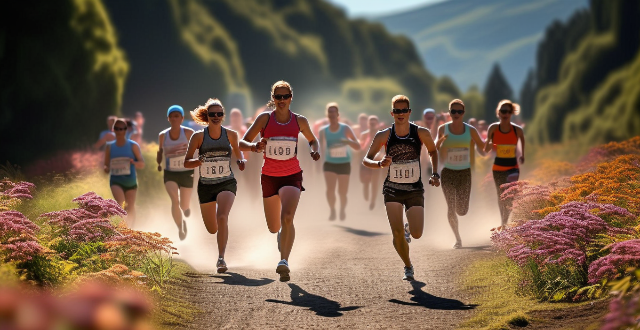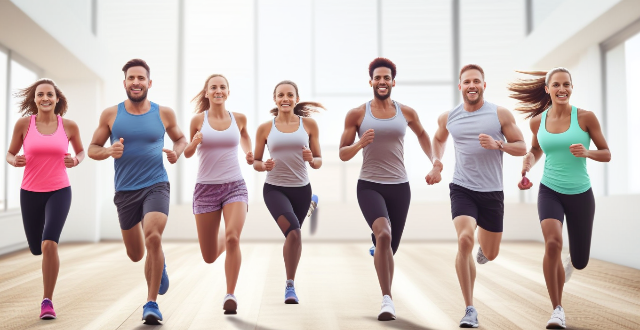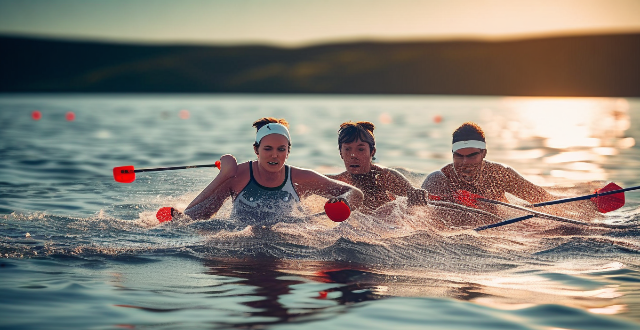Race Runner

How do I prevent injuries during marathon training ?
Preventing injuries during marathon training is crucial for a successful and enjoyable race. To reduce the risk of injury, runners should warm up and cool down properly, gradually increase training intensity, incorporate cross-training, wear proper footwear, stay hydrated and well-nourished, schedule rest days, listen to their bodies, engage in strength training and flexibility work, and prepare for race day with pacing strategies and course familiarization. By following these guidelines, runners can minimize the chances of getting injured and maximize their potential for success on race day.

How can I maintain proper pacing during a race or long run ?
Maintaining proper pacing is crucial for achieving your best performance in a race or long run. To do this, set a realistic goal time based on your training and past performances. Start the race at a slower pace than your goal pace to warm up your muscles and avoid starting too fast. Use a running watch or app to track your pace and distance during the race, and focus on your breathing to maintain a steady rhythm. Stay hydrated by drinking water or sports drinks regularly, and adjust your pace as needed if you feel like you're running too fast or too slow. Practice pacing in training so that it becomes second nature during races. By following these tips, you can achieve your best performance while listening to your body and adjusting your pace as needed.

What kind of training do I need to participate in a marathon or trail run ?
To participate in a marathon or trail run, it is essential to have a comprehensive training plan that focuses on endurance, strength, speed, and recovery. This includes gradually increasing the distance of long runs, incorporating tempo runs and hill repeats for endurance, core workouts and lower body exercises for strength, interval training and fartlek for speed, as well as prioritizing adequate sleep and nutrition for recovery. Mental preparation techniques like visualization and goal setting can also be beneficial. On race day, pacing strategies, equipment checks, and a detailed race plan are crucial for success.

What are some examples of successful sports charity events ?
Successful sports charity events like the Nike Foundation's "Girl Effect" Marathon, The Komen Race for the Cure, and The Wounded Warrior Project's Carry Forward 5K have raised millions of dollars for various causes by combining the excitement of sports with philanthropy. These events engage participants in physical activity, raise funds and awareness for important causes, and create a sense of community among participants and supporters.

What are the benefits of participating in adventure races ?
Adventure races offer numerous benefits including improved cardiovascular fitness, muscular strength, weight management, stress reduction, enhanced cognitive function, emotional well-being, adventure and fun, personal growth, community involvement, and more. These multi-discipline events challenge participants physically and mentally while promoting overall health and wellness. Whether seeking a thrilling experience, personal development, or simply enjoying nature, adventure races provide an excellent way to achieve these goals while having fun and creating lasting memories.

How long should I train for a marathon ?
The length of time you should train for a marathon depends on your current fitness level, running experience, and goals. Most training plans range from 12 to 26 weeks. Beginners may need longer training plans of 18-26 weeks to build up their endurance and avoid injury, while intermediate runners may follow a 14-18 week plan. Advanced runners may be able to follow a shorter training plan of 12-16 weeks, but still need to build up mileage gradually and incorporate rest days to avoid burnout. Sample training plans are provided based on different levels of experience.

How do I measure progress in my sports training plan ?
Measuring progress is crucial for athletes to track development and adjust their training plans. Set SMART goals, track performance, evaluate technique, monitor body composition, assess fitness level, and reflect on mental state to measure progress effectively.

What impact do sports have on the emotional content of a story or poem ?
The impact of sports on emotional content in stories and poems is significant, evoking a range of emotions including joy, sadness, excitement, disappointment, triumph, perseverance, camaraderie, and friendship. Sports can inspire readers with the accomplishments of athletes who win competitions or achieve personal bests, create a sense of excitement and happiness among readers, lead to feelings of disappointment and sadness when an athlete fails to meet their goals or suffers an injury, inspire readers with the resilience and dedication of athletes who overcome injuries or setbacks to achieve success, showcase the importance of friendship and loyalty through teamwork and camaraderie, and evoke feelings of warmth and affection between characters in a story or poem. By incorporating sports into their writing, authors can create compelling narratives that resonate with readers on an emotional level.

What role does visualization play in sports performance ?
Visualization is a powerful tool that can enhance sports performance by improving focus, confidence, technique, recovery, and motivation. It involves creating mental images of desired outcomes or actions, which can lead to better concentration, increased self-efficacy, enhanced motor learning, reduced risk of injuries, and higher levels of motivation. By incorporating visualization into their training routines, athletes can strengthen their physical and mental capabilities, resulting in improved performance during competition and training.

What are the best running shoes for beginners ?
Finding the best running shoes for beginners involves considering factors such as comfort and fit, traction and durability, weight and responsiveness, style and personal preference. Look for shoes with adequate cushioning, arch support, well-padded tongue and collar, durable outsole, sturdy midsole, breathable upper material, lightweight design, responsive cushioning, flexible sole, appealing color and design, reputable brand reputation, and reasonable price point. By taking these factors into account, you can find a pair of running shoes that will support your journey towards becoming a regular runner.

What are some must-have sports equipment for runners ?
Running is a popular form of exercise that requires minimal equipment. However, having the right gear can make your running experience more comfortable, enjoyable, and safer. Here are some must-have sports equipment for runners: 1. **Running Shoes** - A good pair of running shoes will provide support, cushioning, and stability to your feet and ankles during your run. Look for shoes that fit well and are designed specifically for running. 2. **Socks** - Socks made from moisture-wicking materials like polyester or nylon can help keep your feet comfortable and blister-free during long runs. 3. **Running Clothes** - Choose clothing made from synthetic materials like polyester or nylon, which draw sweat away from your body and dry quickly. 4. **GPS Watch or Fitness Tracker** - A GPS watch or fitness tracker can help you keep track of your pace, distance, and other metrics while running. 5. **Hydration System** - A hydration system like a hydration belt, handheld water bottle, or hydration pack can help you stay hydrated during long runs in hot weather. 6. **Reflective Gear** - Wearing reflective gear is essential for staying visible to drivers and other pedestrians when running at night or in low-light conditions. 7. **Sun Protection** - Protect yourself from the sun's harmful UV rays by wearing a hat with a brim and applying sunscreen to exposed skin before heading out. 8. **Fuel and Nutrition** - For longer runs, carrying fuel and nutrition like energy gels, chews, or bars can help maintain your energy levels and prevent muscle cramps. Invest in quality equipment that suits your needs and preferences, and don't forget to replace worn-out items regularly to maintain their effectiveness and safety.

What are the best training methods for a marathon ?
The article provides a summary of the best training methods for a marathon, including long runs, interval training, hill training, tempo runs, cross-training, recovery weeks, race pace workouts, and tapering. It emphasizes the importance of consistency, patience, and listening to one's body during training.

Are there any events or clubs that organize group cycling trips on specific routes ?
There are many events and clubs that organize group cycling trips on specific routes, providing opportunities for cyclists to explore new places, meet other riders, and enjoy shared experiences. Examples include the Gran Fondo World Championships, Tour de Cure, RAAM, local cycling clubs, bike shops, and online communities like Strava, Facebook, and Meetup. These organizations offer a range of rides and races, from beginner to advanced levels, and cater to different interests such as road biking, mountain biking, and fundraising.

What are the most common causes of sports injuries ?
Sports injuries can be caused by a variety of factors, including physical stress, poor technique, inadequate equipment, and environmental conditions. Overuse injuries occur when an athlete repeatedly performs the same motion or activity without adequate rest or recovery time. Traumatic injuries are typically caused by sudden impact or forceful contact during sports activities. Improper technique while participating in sports can increase the risk of injury. Inadequate equipment can also increase the risk of injury. Environmental conditions such as weather, terrain, and lighting can contribute to sports injuries.

What role does data analytics play in modern sports ?
Data analytics is a crucial tool in modern sports, revolutionizing training, strategy, and performance. It helps track and evaluate performance metrics, prevent injuries, inform game strategies, identify talented athletes, and enhance fan engagement.

What are some famous examples of sports-inspired art ?
Sports have been a significant source of inspiration for artists, resulting in various forms of art that capture the essence of athleticism and competition. Notable examples include Rubens' "The Chariot Race," Degas' "Olympia" series, Neiman's painting of the Muhammad Ali vs. George Foreman match, Sennwald's photographic series on Wilt Chamberlain, Banksy's Tour de France-inspired graffiti, Goya's "The Boxer," Darnell's oil paintings of Michael Jordan, Orzechowski's watercolors of female Olympians, Djordjevic's abstract sculpture of speed skaters, and Botero's soccer player sculptures and paintings. These works showcase the dynamic nature of sports and the human spirit through various artistic styles and mediums.

What is the psychology behind the "runner's high" and its impact on mental health ?
The "runner's high" is a state of euphoria or pleasure experienced during or after intense physical activity, such as running. It is linked to the release of endorphins in the brain, which act as natural painkillers and mood enhancers. The psychology behind this phenomenon involves several factors, including endorphin release, stress reduction through lowering cortisol levels, and social interaction. The "runner's high" has positive impacts on mental health, such as reduced anxiety and depression, improved self-esteem, better sleep quality, and increased resilience. By understanding these factors and incorporating regular physical activity into our lives, we can improve our mental health and overall well-being.

What is the physiological basis for the "runner's high" phenomenon ?
The runner's high is a state of euphoria experienced by long-distance runners, believed to have a physiological basis. Endorphins, natural opioid peptides that reduce pain perception and create feelings of pleasure, are key players in this phenomenon. Other factors like adrenaline, norepinephrine, serotonin, dopamine, and cortisol also contribute. The benefits include pain relief, mood enhancement, stress reduction, and improved self-esteem.

What are the benefits of interval training for runners ?
Interval training is a method of exercise that involves alternating periods of high-intensity activity with periods of low-intensity activity or rest. For runners, this means alternating between running at a fast pace and jogging or walking. Here are some benefits of interval training for runners: 1. Improved Cardiovascular Fitness: Interval training can help improve cardiovascular fitness by increasing the heart rate and breathing rate during the high-intensity intervals. This can lead to improved endurance and stamina, allowing runners to run longer distances without getting tired as quickly. 2. Fat Loss: Interval training is an effective way to burn fat and lose weight. The high-intensity intervals cause the body to burn more calories than steady-state cardio exercises like jogging or running at a consistent pace. This can lead to faster weight loss and a leaner physique. 3. Increased Speed and Power: Interval training can also help increase speed and power in runners. By pushing the body to its limits during the high-intensity intervals, runners can improve their muscle strength and power, which can lead to faster running times and better performance in races. 4. Time Efficiency: Interval training is a time-efficient way to train for runners. Because it involves short bursts of high-intensity activity, it can be done in less time than traditional steady-state cardio exercises like jogging or running at a consistent pace. This makes it an ideal workout for busy athletes who want to maximize their time spent exercising. 5. Reduced Risk of Injury: By incorporating periods of low-intensity activity or rest into their workout routine, runners can reduce their risk of injury from overuse or repetitive strain injuries. This is because interval training allows the body to recover between high-intensity intervals, reducing the stress on joints and muscles.

What is the importance of biomechanics in sports research and development ?
Biomechanics is crucial in sports research and development. It involves the study of body movement and its interaction with external forces. By understanding biomechanics, athletes can improve performance, reduce injury risk, and enhance athletic ability. Biomechanics helps identify areas for improvement, prevent injuries, and develop better coordination and control. Overall, it's essential for athletes to reach their full potential.

What are some popular books discussed in celebrity book clubs ?
The text provides a list of eight books that have been popular in celebrity book clubs. Each book is summarized, including its author, genre, and a brief summary of its content. The books cover a range of topics, from personal memoirs to historical fiction, and explore themes such as identity, race, family, education, and resilience.

What role does mental preparation play in improving running performance ?
Mental preparation is key to improving running performance. It involves setting clear goals, using visualization techniques, practicing mindfulness exercises, and employing self-talk strategies. By training the mind to focus on the task at hand, manage stress, and maintain motivation, runners can enhance their physical performance and achieve their running goals.

What is the latest update on the NBA trade deadline ?
The NBA trade deadline has passed, resulting in severalThe NBA trade deadline has passed, resulting in several impact the league's play resulting in several notable trades that could impact the league's playoff race and future team dynamics. Key trades include the Boston Celtics acquiring Evan Fournier, the San Antonio Spurs sending LaMarcus Aldridge to the Brooklyn Nets, the Golden State Warriors acquiring Andrew Wiggins and D'Angelo Russell, and the Miami Heat acquiring Andre Iguodala. These moves have implications for both the teams involved and the league as a whole, with potential shifts in power and long-term effects on player development and team rebuilding efforts. Fan reactions to these trades have been mixed, with excitement and disappointment among different fan bases.

Can you explain the concept of intersectionality as it relates to women's rights ?
Intersectionality is a term used to describe the interconnectedness of various forms of oppression and discrimination, including race, gender, sexuality, class, ability, and other factors. It recognizes that individuals can experience multiple forms of discrimination simultaneously, and acknowledges that not all women have the same experiences or face the same challenges. Intersectionality advocates for an approach that takes into account all aspects of a person's identity and experiences, recognizing and addressing the ways in which different forms of discrimination overlap and intersect. This concept is important for understanding and addressing women's rights because it recognizes the diversity of women's experiences and the need for a nuanced approach to advocacy and policy-making.

What is the definition of equitable vaccination distribution ?
Equitable vaccination distribution is the fair and just allocation of vaccines to all individuals, regardless of their socioeconomic status, race, ethnicity, or geographic location. It ensures that everyone has equal access to vaccines and can receive them in a timely manner. Key principles include fairness, transparency, solidarity, accountability, efficiency, respect for human rights, and scientific evidence-based decision making. Examples of equitable practices include prioritizing high-risk groups, addressing geographical disparities, promoting diversity and inclusion, and collaborating with international organizations. Equitable distribution is crucial for achieving herd immunity and ending the pandemic, protecting vulnerable populations, reducing health disparities, and saving lives.

How can I improve my running form and avoid injuries ?
Improving your running form is crucial for both performance enhancement and injury prevention. Here are some tips on how to improve your running form and avoid injuries: 1. Proper Warm-Up and Cool-Down 2. Focus on Posture 3. Foot Strike and Landing 4. Cadence and Step Length 5. Strength Training and Cross-Training 6. Wear Proper Footwear 7. Gradual Progression 8. Listen to Your Body

How does exercise physiology help in preventing sports injuries ?
Exercise physiology helps prevent sports injuries by understanding body mechanics, energy systems, and recovery needs. Athletes can reduce injury risk through proper warm-up/cool-down, cross-training, progressive overload, and sufficient recovery time.

How can I avoid overuse injuries in sports ?
Overuse injuries are common among athletes, especially thoseOveruse injuries are common among athletes, especially those sport or engage in repet Participate in multiple sports or activities that use different muscle groups to reduce repetitive stress on specific body parts. 2. Proper Technique: Use correct form and technique for your sport to prevent unnecessary strain on your body. 3. Gradual Progression: Gradually increase the intensity, duration, and frequency of your training sessions to avoid sudden increases that can lead to overuse injuries. 4. Adequate Recovery Time: Schedule regular rest days, get enough sleep, and consume a balanced diet to aid in recovery and prevent overuse injuries. 5. Stretching and Strengthening Exercises: Incorporate stretching and strengthening exercises into your routine to improve flexibility and reduce the risk of overuse injuries. 6. Listen to Your Body: Pay attention to how your body feels during and after training sessions, and address any persistent pain or discomfort promptly by seeking medical advice and adjusting your training regimen accordingly.